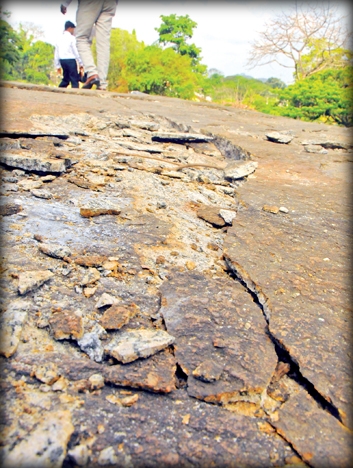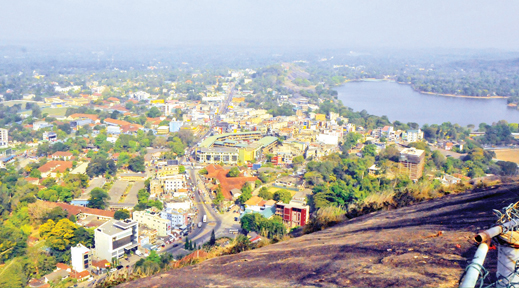A molehill in a mountain
Athugala rumbled last week, displaying a couple of
fissures that according to experts are of no consequence:
By Keshena Samaraweera and Maneshka Borham
The lumbering rocky giant that stands sentinel over the Kurunegala
town rumbled and roared last week, raising a red flag of concern among
the residents, unsure of what to expect next.
 Of
the seven large rocks that surround Kurunegala, Athugala is the most
magnificent. Standing 316 metres tall and resembling a giant elephant,
the rock is said to be the sole reason behind the various names, ranging
from Athugalpura to Hasthishailapura, given to this majestic city, once
the royal capital of Sri Lanka. Of
the seven large rocks that surround Kurunegala, Athugala is the most
magnificent. Standing 316 metres tall and resembling a giant elephant,
the rock is said to be the sole reason behind the various names, ranging
from Athugalpura to Hasthishailapura, given to this majestic city, once
the royal capital of Sri Lanka.
According to legend, the rocks that define the regal city were once
in fact live animals. It is said the area once suffered a terrible
drought, which dried up all the water sources, endangering the animals
and turning them into rocks. The myth, it is claimed, was designed to
suit the meaning of ‘athugala’, large elephant.
Animal lore notwithstanding, the rock is steeped in history and even
connected to the death of King Parakramabahu the fourth. It is said the
enemies of the King lead him to the summit of the rock under the
pretence of attending a ‘pirith’ chanting ceremony and pushed him off
the rock.
Given the myths, the legend and the royal history associated with the
rock and its significance to the town, the public and the authorities
alike were understandably alarmed when cracks appeared on the rock
surface, following what sounded like a massive explosion.
Two cracks
According to reports, on March 19, people in the surrounding area had
heard an explosion, which on investigation had emerged as the cause of
two cracks on the rock surface. Estimated to be 50 metres long and two
feet deep, the fissures are founds towards the left hand side of the
stairway leading to the 88ft Buddha statue on the top. The stairway
begins near the building complex of the North Western Provincial
Council.
The cracks, though cause for major concern for the residents, have
become a major draw for visitors, who have, despite the oppressive heat,
been coming in their droves for a first hand view of this geographical
phenomenon.
Shantha Perera, 47-year-old, owns a shop at the foot of the rock.
He’s been there for the past 15 years, selling flowers and other small
items to visitors climbing the rock to pay homage to the Buddha statue
located at the top. According to Perera, a large number of people have
been visiting the site since media reported about the cracks. “Usually
people visit Athugala on important poya days. However, these days people
keep visiting, asking for directions to the section where the fissures
have appeared,” he says.
Intense heat
At a time where bizarre explanations and assumptions are being made
about the cause of the cracks, Perera is pragmatic about what has
happened and wonders whether the rupture could be a caused intense heat
reacting to moisture, caused by rainwater and dew collecting at the
crevices. “There is a tendency for rainwater to collect in the area
where the cracks have appeared. This together with the heat could be a
possible cause for the rupture,” he says, adding that most of the
fissures always appear on the left side of the rock
R.M.S Bandara, the head of the Landslide Research and Risk Management
Division of the National Building Research Organisation, attributes the
rupture is to the excessive levels of heat experienced in the past
several months.
The Department of Meteorology is on record stating that temperature
levels in Kurunegala during the day of the incident had reached levels
between 32 and 39 degree Celsius at its highest. “While this was the
highest temperature during nights the temperature drops to around 22
degree Celsius causing the rock to break up in fragments,” Bandara
explains
Deeming it a natural phenomenon, Bandara says the cracks are part of
the cycle of a rock, despite it being a somewhat unusual occurrence in
more normal circumstances.
“But owing to the prevailing weather conditions, this incident is not
one to be alarmed about,” he says, explaining that over a year ago the
Thattambuwawa Rock in Yapahuwa too developed cracks of a similar nature.
Shop owners Perera agrees. “A similar but smaller incident occurred
two years ago on the same side of the rock,” he says, admitting the
rupture is not an uncommon incident as it has been made out to be.
 Dr.
Mahi Kottegoda, President of the Hasthishailapura Buduruwa Development
Society says media reports alarmed Society members compelling them to
send a team to Athugala to observe the situation as they were concerned
about the statue on the summit. Dr.
Mahi Kottegoda, President of the Hasthishailapura Buduruwa Development
Society says media reports alarmed Society members compelling them to
send a team to Athugala to observe the situation as they were concerned
about the statue on the summit.
“We then realised the media had blown the incident out of
proportion,” he points out, adding there is no danger to the statue or
surrounding areas. “In certain areas you notice the rock shows signs of
decay due to exposure but the situation is not dangerous” he emphasises.
Not dangerous
Bandara confirms this and when questioned about how safe it is to
visit Athugala in the future, says, “The cracks will not develop further
and cause severe damage to the rock creating a dangerous situation.”
Meanwhile, Assistant Director of the Disaster Management Coordinating
unit of the Kurunegala District Secretariat, W.M.S.G Wanninayake, says
no warning has been issued to those living in the vicinity of the rock
as the incident is not considered to be dangerous. He says no special
precautions have been taken either.
Despite his worries, Perera too says no warning has been given to
them to leave the area.
According Bandara media reports on the cracks on Athugala is somewhat
confusing as the public seem to assume the rupture has taken place on
top of the rock where the Buddha statue is located. “But in fact the
cracks have appeared at the very base of the rock,” he says, emphasising
that there is no cause for alarm.
So for now the proud residents of Kurunegala can rest easy while
Athugala will continue to watch over this historical city. |

